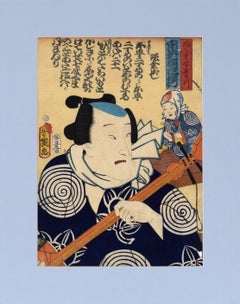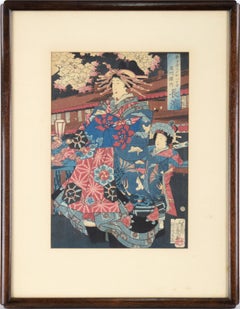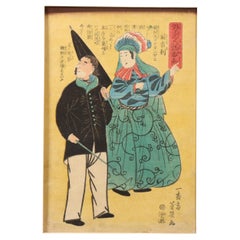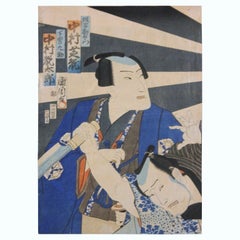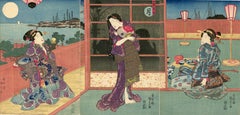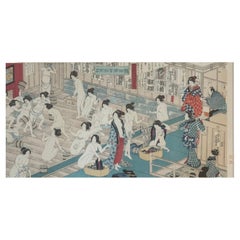Utagawa Yoshiiku Art
to
1
2
1
3
2
2
"Candy Seller" Japanese Woodblock on Rice Paper
By Utagawa Yoshiiku
Located in Soquel, CA
"Candy Seller" (飴売りうずまつ 市村羽左衛門) Japanese Woodblock on Rice Paper
This piece depicts Ichimura Uzaemon as the Candy Peddler Uzumatsu. He is playing a stringed instrument (the shamisen) to attract people to come buy canbdy. The spiral on his clothing is the symbol of the candy seller, along with his crest of the mandarin orange.
This Utagawa Yoshiiku print, titled "Umegoyomi mitate hachi shojin" (梅暦見立八笑人), depicts a scene from the Edo period. The print features a prominent male figure playing a shamisen, a traditional Japanese stringed instrument. The text on the print is in Japanese, and the overall style is characteristic of Ukiyo-e, a genre of Japanese woodblock prints. Utagawa Yoshiiku was a significant artist of the Meiji era, known for his contributions to woodblock printmaking. He was a student of Utagawa Kuniyoshi and worked alongside Tsukioka Yoshitoshi. His works often portray historical events, scenes from Kabuki plays, and contemporary life. This print, in particular, showcases the artist's skill in capturing the details of clothing, facial expressions, and the musical instrument.
Presented in a new blue mat with foam core backing.
Mat size: 18"H x 14"W
Paper size: 16"H x 12"W
Born the son of teahouse proprietor Asakusa Tamichi in 1833, Utagawa Yoshiiku (also known as Ochiai Yoshiiku) became a student of ukiyo-e artist Utagawa Kuniyoshi toward the end of the 1840s. His earliest known work dates to 1852 when he provided the backgrounds to some actor prints by his master.
Yoshiiku's earliest works were portraits of actors (yakusha-e), beauties (bijin-ga), and warriors (musha-e). He later followed Kuniyoshi into making satirical and humorous pieces, and became the leading name in the field after Kuniyosh's death in 1861. He illustrated the Tokyo Nichi Nichi...
Category
1860s Edo Utagawa Yoshiiku Art
Materials
Ink, Rice Paper, Woodcut
Courtesans at Yoshiwara Edomachi - Figurative Japanese Woodblock Print on Paper
By Utagawa Yoshiiku
Located in Soquel, CA
Courtesan at Yoshiwara Edomachi - Figurative Japanese Woodblock Print on Paper
Full color woodcut print of two women in elaborate gowns by Utagawa Yoshiiku (Ochiai Yoshiiku) (Japanese, 1833-1904). Two women are dressed in colorful robes with crossed arms. They are underneath a plum blossom tree in bloom, at night. In the background there is a building with many rooms. Valuable polychrome woodblock print of vertical large oban (大判) format made by Utagawa Yoshiiku (歌川芳幾), the famous artist also known as Ochiai Yoshiiku (落合芳幾), and depicting the courtesan Shizuka (しづか), of the house of pleasure Matsumotoro (松本楼), together with her young kamuro (禿) assistant. The couple is escorted by a kanabohiki (金棒引き) watchman holding a lantern and a metal rod with rings to make noise and alert the crowd.
The work, produced in August 1869 by the publisher Tsunajima Kamekichi (綱島亀吉), is taken from the “Twelve Months of Yoshiwara” (よし原十二ヶ月のうち), an elegant series of prints dedicated to the famous red light district of Edo (江戸), and is paired with the “month of leaves” Hazuki (葉月), that is August.
Ochiai Yoshiiku (Japanese, 1833-1904) was an ukiyo-e artist from the end of the Edo Period to the Meiji Period. He has created works which are essential to the history of ukiyo-e, such as“Twenty-eight Famous Murders with Verse”, a series of chimidoro-e (bloody paintings) which Yoshiiku and Tsukioka Yoshitoshi collaborated together, and “Shimbun (newspaper) Nishiki-e” that illustrated Meiji news articles with ukiyo-e.
Born the son of teahouse proprietor Asakusa Tamichi in 1833, Yoshiiku became a student of ukiyo-e artist Utagawa Kuniyoshi toward the end of the 1840s. His earliest known work dates to 1852 when he provided the backgrounds to some actor prints by his master.
Yoshiiku's earliest works were portraits of actors (yakusha-e), beauties (bijin-ga), and warriors (musha-e). He later followed Kuniyoshi into making satirical and humorous pieces, and became the leading name in the field after Kuniyosh's death in 1861. He illustrated the Tokyo Nichi Nichi...
Category
1860s Impressionist Utagawa Yoshiiku Art
Materials
Paper, Ink, Woodcut
Antique Edo Woodblock Print, People from Foreign Lands: English Persons, 1861
By Utagawa Yoshiiku
Located in Amsterdam, Noord Holland
1861 Woodblock Utagawa Yoshiiku People from Foreign Lands: English Persons
signed Ikkeisai Yoshiiku, publisher’s seal Maru Tetsu (Teijudo), with censor’s date seal Tori-ni, aratame ...
Category
19th Century Japanese Edo Antique Utagawa Yoshiiku Art
Materials
Paper
Related Items
Two Kabuki Actors Japanese Woodblock Print
By Toyohara Kunichika
Located in Houston, TX
Two kabuki actors posing a samurai's. The print is printed on rice paper and is not framed. It is stamped by the artist with details about the actors in ...
Category
1860s Edo Utagawa Yoshiiku Art
Materials
Woodcut
Japanese Beauties Enjoy a Full Moon
By Utagawa Kunisada (Toyokuni III)
Located in Burbank, CA
"Sun, Moon and Stars". Three beauties enjoy a full moon on the veranda of a teahouse or restuarant. The woman on the left kneels and adjusts her lavishly printed kimono. The beauty in the center has her hair down, and behind her is a screen against which shadows are beautifully silhouetted, which adds an air of mystery. The seated woman on the right is perhaps a geisha, as we see a shamisen lying next to her. Before her is a tray with an assortment of foods. One may surmise that the beauties are being compared to the sun, the moon, and the stars. On the left we glimpse a full moon shining over the peaceful bay, and boats at harbor. Original first edition Japanese color woodblock print triptych...
Category
1840s Edo Utagawa Yoshiiku Art
Materials
Mulberry Paper, Woodcut
$3,600
H 14.18 in W 29.06 in
Tolosa (Toulouse); Leaf LXXI from Hartmann Schedel's Nuremberg Chronicle
Located in Middletown, NY
Woodcut on laid paper, 8 3/8 x 9 1/8 inches (212 x 233 mm), the full sheet. In excellent condition with text and portraits of Empedocles, Sapho, Zeuxis and others on the verso, as is...
Category
15th Century and Earlier Old Masters Utagawa Yoshiiku Art
Materials
Ink, Handmade Paper, Laid Paper, Woodcut
Ito Takashi Landscape Woodblock Print, "Mt. Fuji from Susono", Signed
Located in New York, NY
Ito Takashi Landscape Woodblock: Mt. Fuji from Susono. Beautiful Japanese woodblock with good colors; under glass with 1960s era matting and framing. The b...
Category
1950s Japanese Mid-Century Modern Vintage Utagawa Yoshiiku Art
Materials
Paper
$900 Sale Price
60% Off
H 16 in W 20 in D 1 in
Rare 1922 German Jewish Judaica Zion Woodcut Woodblock Print Hermann Fechenbach
By Hermann Israel Fechenbach
Located in Surfside, FL
Title: Zion
Subject: Various biblical images depicting Creation and prayer
1922
Medium: woodcut
Frame: 14" x 18"
Image: 12.5" x 16.75"
Provenance: owned and signed verso by Peter Keil.
Central panel shows the Jewish star over a crown, with inscription in Hebrew: "When God comforts Zion, He will comfort all its ruins and make its deserts look like Eden," and "You have sanctified the seventh day, the goal of creation of Heaven and Earth." This is flanked by a Palestinian farmer pioneer on the left and a Jew praying on the right. The lower tier shows six vignettes of the days of creation from Genesis.
Hermann Fechenbach was born in 1897 in Württemberg, Germany. He grew up in Bad Mergentheim where his parents had an inn, which served as a meeting place for the local Jewish community.
He left school early and through family connections with clothing retailers received training in window dressing. His skill with brush writing was quickly recognised by a big firm in Dortmund where he was responsible for the displays in 10 large windows. He received his conscription papers in 1916 and recalls “being as patriotic as any other fool”. In August 1917 he was involved in a grenade attack in which he was the sole survivor. With serious injuries to both legs he struggled to safety and was eventually transported to a front line “slaughterhouse” where the first of a series of amputations was performed which led to the loss of his left leg.
As a result of his injuries his father dropped his opposition to him becoming an artist. His formal art education started in 1918 with training at a Stuttgart handcraft school for invalids. He attended the Academies in Stuttgart and Munich to learn painting and restoration for 3 years. He was influenced at this time by Max Liebermann. He has been compared to Kathe Kollwitz and was a contemporary of Jakob Steinhardt and hermann Struck. In 1923 he went to Florence for a year. While in Florence he started to produce a series of miniature wood engravings to illustrate the stories of Genesis. This was followed by periods in Pisa, Venice, Vienna and Amsterdam. In 1924 he returned to Stuttgart to paint in the contemporary style “Die Neue Sachlichkeit”. (The New Objectivity was a movement in German art that arose during the 1920s Weimar republic as a reaction against expressionism. The term was coined by Gustav Friedrich Hartlaub, the director of the Kunsthalle in Mannheim, who used it as the title of an art exhibition staged in 1925 to showcase artists who were working in a post-expressionist spirit. These artists—who included Max Beckmann, Otto Dix, George Grosz, Christian Schad, Rudolf Schlichter and Jeanne Mammen) Every spring and autumn he exhibited at the “Kunstgebit” which served as the showcase for all serious artists of the period.
His professional status “Kunstmaler und Grafiker” was recognised by Berlin in 1926. Practically all his work from this period was sold following exhibition.
In 1926 he collaborated with an architect friend to build a bungalow in Hohenheim, a non-Jewish area and a suburb of Stuttgart. Hermann alternately lived in his country bungalow and his town studio, producing portraits for sale or barter and wood engravings for his own pleasure.
In 1930 he married a non-Jewish professional photographer – Greta Batze. They had a studio in Stuttgart, which was used to teach art to a group of 12 students.
In 1933 the Nazi influence removed his name from the official state register together with the right to exhibit. By spending most of his time in his bungalow out of the Jewish quarter the Fechenbachs escaped being registered by the Nazis for some years. They were ostracised and abused by their non-Jewish neighbours. Hermann made weekly visits to friends in town to teach them the practical skills they would need assuming they were to escape from Germany. His energies were directed towards protection and survival.
Ultimately the Nazi persecution forced the Fechenbachs to flee their homeland. They moved to Palestine for 3 months in 1938, but found the political and physical environment unsustainable.
Greta arrived in England penniless in January 1939 to work as a domestic servant and to find a guarantor for her husband. Hermann arrived in May 1939. They moved to Blackheath a few months later. Hermann resumed his painting and engraving as a means of earning a living. He raised enough money to get his parents out of Germany to join his brothers in Argentina but was unable to save his twin sister Rosa who died in a Nazi concentration camp. In 1940 Hermann was interned in Bury as a suspect alien. He protested about his treatment by starting a hunger strike. Because of his persistence he was moved to a prison in Liverpool. From Liverpool he was moved to the Hutchinson Camp in the Isle of Man with fellow artist Kurt Schwitters. Arrangements were made for Greta to be accommodated near by. While interned he commenced work on “Refugee Impressions”, a series of linocut prints (no wood was available).
In 1941 when released from internment the Fechenbachs came under the sponsorship of Dr. Bela Horovitz, the Austrian art publisher who in turn made an introduction to Professor Tancred Borenius.
They were offered lodgings with a family in Oxford. Hermann had his first public exhibition for many years in a small gallery in Oxford in 1942. A second exhibition of oils, pencil drawings, coloured linocut and woodblock prints held later in the year was opened by the mayor of Oxford and critically acclaimed.
In 1944 the first London exhibition took place at the Anglo-Palestinian club in Piccadilly. There were two exhibitions at the Ben Uri Art gallery during this period.
In 1948 a second exhibition at the Anglo Palestinian club was inaugurated by a member of the Rothschild family and several members of Parliament. This was a great success.
In 1944 the Fechenbachs moved to a top floor studio flat in Colet Gardens. Open exhibitions were held each Spring at the Embankment from 1946 to 1951. Movietone News produced a short feature on the artist, which was shown in cinemas in England and Germany.
In 1969 he published the Genesis story in a hard back volume containing 137 prints. He started to research the fate of the entire Jewish community of Bad Mergentheim during the period of the second world war, liaising with historian Dr. Paul Sauer and Professor Max Miller, historian and theologian. In 1972 Kohlhammer published his partly autobiographical book “The last Jews of Mergentheim”. He exhibited at the Anglo-Palestinian Club & the Ben Uri Gallery in the 1940s. His works only came to prominence during the last year of his life when he exhibited at Blond Fine Art.
Peter Keil part of the Junge Wilde. In 1978, the Junge Wilde painting style arose in the German-speaking world in opposition to established avant garde, minimal art and conceptual art. It was linked to the similar Transavanguardia movement in Italy, USA (neo-expressionism) and France (Figuration Libre). They were also known as the Neue Wilde. Artists included; Austria: Siegfried Anzinger, Erwin Bohatsch, Herbert Brandl, Gunter Damisch, Hubert Scheibl, Hubert Schmalix...
Category
1980s Impressionist Utagawa Yoshiiku Art
Materials
Woodcut
19th century color woodcut Japanese ukiyo-e print female geisha figure signed
By Utagawa Kuniyoshi
Located in Milwaukee, WI
This print is from a highly regarded series by the Edo woodblock artist Utagawa Kuniyoshi: in the period, there were at times prohibitions in depicting a...
Category
1850s Edo Utagawa Yoshiiku Art
Materials
Pigment, Paper, Woodcut
Utagawa Kuniyoshi19th century color woodcut Japanese ukiyo-e print female geisha figure signed, 1852
$3,200 Sale Price
20% Off
H 21.5 in W 17.5 in
The Triumph of Caesar: Plate IV
By Andrea Mantegna
Located in Middletown, NY
Andreani, Andrea (Italian, about 1558–1610), after Andrea Mantegna (Italian, 1431-1506)
Chiaroscuro woodcut in colors printed from four blocks on laid paper in dark brown, grey, and...
Category
16th Century Old Masters Utagawa Yoshiiku Art
Materials
Ink, Handmade Paper, Laid Paper, Woodcut
Seishi Ai-oi Genji – Set of 12 Shunga works together w/astrological commentary
By Utagawa Kunisada (Toyokuni III)
Located in Middletown, NY
Set of 12 woodblock prints in colors on handmade, laid mulberry paper, 6 3/4 x 10 1/4 inches (170 x 258 mm), printed in Ka-ei 4 (1851). Each print with minor handling wear, otherwise in excellent condition with bright and fresh color, and with details printed in silver ink. The images themselves contain several illusive characters indicating the publisher which are obfuscated by figures, as intended. Presented loose, as issued. A fine set.
The astrological commentary print has a large and meandering blind stamp with a bird and palm frond motif. This print lists various phrases concerning the Twelve Zodiac Animals as historically counted in Japan, and appears to include erotic commentary on the traits of people born under each of the twelve signs.
These Shunga images were issued in books that paralleled (in an erotic fashion...
Category
Mid-19th Century Edo Utagawa Yoshiiku Art
Materials
Handmade Paper, Ink, Woodcut
Black Horse
By Tokuriki Tomikichiro
Located in Middletown, NY
circa 1950.
Woodblock print in black and gray ink on Japon laid paper, 10 1/4 x 15 3/4 inches (260 x 398 mm), full margins. With the artist's embossed chop mark in red ink in the l...
Category
Mid-20th Century Edo Utagawa Yoshiiku Art
Materials
Handmade Paper, Woodcut
The Triumph of Caesar: Plate IV of IX
By Andrea Mantegna
Located in Middletown, NY
Andreani, Andrea, after Andrea Mantegna
The Triumph of Caesar: Plate IV of IX
1599. Chiaroscuro woodcut in colors printed from four blocks on laid paper in dark brown, grey, and thr...
Category
16th Century Old Masters Utagawa Yoshiiku Art
Materials
Handmade Paper, Laid Paper, Ink, Woodcut
Utagawa Kunisada Japanese Woodblock Print
By Utagawa Kunisada (Toyokuni III)
Located in Miami, FL
A fine, professionally framed original Japanese woodblock print attributed to the master Utagawa Kunisada (1786 – 1865), also known as Utagaw...
Category
19th Century Japanese Edo Antique Utagawa Yoshiiku Art
Materials
Wood, Paper
Jose Luis Cuevas original artist proof signed woodcut Ghosts of downtown V paper
By José Luis Cuevas
Located in Miami, FL
Jose Luis Cuevas (Mexico, 1934-2017)
Artist Proof
'Fantasmas del Centro Histórico V', 2004
woodcut on paper Guarro Biblos 250g.
20.9 x 16 in. (53 x 40.5 cm.)
Edition of 60
Unframed
I...
Category
Early 2000s Contemporary Utagawa Yoshiiku Art
Materials
Paper, Woodcut, Ink
Previously Available Items
Vintage Japanese Woodblock Print "Interior of a Public Bath" by Utagawa Yoshiiku
By Utagawa Yoshiiku
Located in San Diego, CA
Vintage Japanese woodblock print "Interior of a Public Bath" by Utagawa Yoshiiku, circa 1950s. The print is in good vintage condition and measures 22.5" x 13.5" ( the image is 18" x ...
Category
Early 20th Century Japanese Mid-Century Modern Utagawa Yoshiiku Art
Materials
Paper
H 13.5 in W 22.5 in D 1 in
Utagawa Yoshiiku art for sale on 1stDibs.
Find a wide variety of authentic Utagawa Yoshiiku art available for sale on 1stDibs. You can also browse by medium to find art by Utagawa Yoshiiku in woodcut print, ink, paper and more. Much of the original work by this artist or collective was created during the 19th century and is mostly associated with the Impressionist style. Not every interior allows for large Utagawa Yoshiiku art, so small editions measuring 10 inches across are available. Customers who are interested in this artist might also find the work of Adolphe APPIAN, Utagawa Yoshitora, and Kunichika Toyohara. Utagawa Yoshiiku art prices can differ depending upon medium, time period and other attributes. On 1stDibs, the price for these items starts at $436 and tops out at $755, while the average work can sell for $540.
